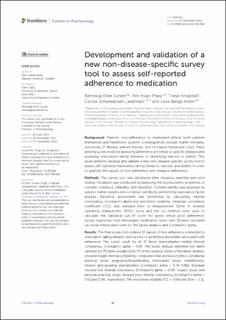| dc.description.abstract | Background: Patients’ non-adherence to medication affects both patients themselves and healthcare systems. Consequences include higher mortality, worsening of disease, patient injuries, and increased healthcare costs. Many existing survey tools for assessing adherence are linked to specific diseases and assessing medication-taking behavior or identifying barriers or beliefs. This study aimed to develop and validate a new non-disease-specific survey tool to assess self-reported medication-taking behavior, barriers, and beliefs in order to quantify the causes of non-adherence and measure adherence.
Methods: The survey tool was developed after literature searches and pilot testing. Validation was conducted by assessing the psychometric properties of content, construct, reliability, and feasibility. Content validity was assessed by subject matter experts and construct validity by performing exploratory factor analysis. Reliability assessment was performed by calculating internal consistency, Cronbach’s alpha and test/retest reliability, intraclass correlation coefficient (ICC), and standard error of measurement (SEm). A receiver operating characteristic (ROC) curve and the Lui method were used to calculate the statistical cut-off score for good versus poor adherence. Survey responses from Norwegian medication users over 18 years recruited via social media were used for the factor analysis and Cronbach’s alpha.
Results: The final survey tool contains 37 causes of non-adherence connected to medication-taking behavior and barriers to adherence and beliefs associated with adherence. The overall result for all 37 items demonstrated reliable internal consistency, Cronbach’s alpha = 0.91. The factor analysis identified ten latent variables for 29 items, explaining 61.7% of the variance. Seven of the latent variables showed reliable internal consistency: medication fear and lack of effect, conditional practical issues, pregnancy/breastfeeding, information issues, needlessness, lifestyle, and avoiding stigmatization (Cronbach’s alpha = 0.72–0.86). Shortage showed low internal consistency (Cronbach’s alpha = 0.59). Impact issues and personal practical issues showed poor internal consistency (Cronbach’s alpha = 0.51 and 0.48, respectively). The test/retest reliability ICC = 0.89 and SEm = 1.11, indicating good reliability. The statistical cut-off score for good versus poor adherence was 10, but the clinical cut-off score was found to be 2.
Conclusion: This survey tool, OMAS-37 (OsloMet Adherence to medication Survey tool, 37 items), demonstrated to be a valid and reliable instrument for assessing adherence. Further studies will examine the ability of the tool for measuring adherence enhancing effect following interventions. | en_US |

